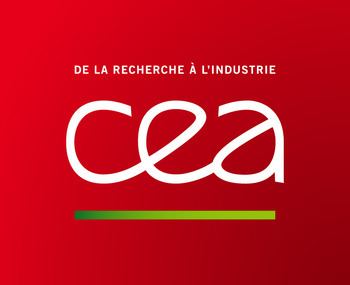Formed October 18, 1945 Annual budget 4.7 billion € (2009) Founded 18 October 1945 | Employees 15,989 (2010) | |
 | ||
Preceding agency Commissariat à l'énergie atomique Agency executives Daniel Verwaerde, General administratorYves Bréchet, High Commissioner for Atomic Energy Website www.cea.fr (in English) Profiles | ||
The [French] Alternative Energies and Atomic Energy Commission or CEA (French: Commissariat à l'énergie atomique et aux énergies alternatives), is a French public government-funded research organisation in the areas of energy, defense and security, information technologies and health technologies. The CEA maintains a cross-disciplinary culture of engineers and researchers, building on the synergies between fundamental and technological research.
Contents
- Organisation
- The division of technological research DRT
- CEA Leti
- CEA List
- CEA Liten
- The division of military applications DAM
- Civilian research centres
- Civilian emergency organizations
- Research centres for military applications
- Subsidiaries and minority interests
- University Paris Saclay Universit Paris Saclay
- INSTN
- Others
- References
CEA is headed by a board headed by the general administrator (currently Daniel Verwaerde), advised by the high-commissioner for atomic energy (currently Yves Bréchet). The missions of the CEA are equivalent to those of the United States Department of Energy. Its yearly budget amounts to 4.7 billion euros and its permanent staff is slightly under 16,000 persons. It owns Areva.
CEA was created in 1945; since then, the successive high-commissioners have been Frédéric Joliot-Curie, Francis Perrin, Jacques Yvon, Jean Teillac, Raoul Dautry, René Pellat, Bernard Bigot, and Daniel Verwaerde.
It conducts fundamental and applied research into many areas, including the design of nuclear reactors, the manufacturing of integrated circuits, the use of radionucleides for curing illnesses, seismology and tsunami propagation, the safety of computerized systems, etc.
It has one of the top 100 supercomputers in the world, the Tera-100. TERA 100, first system designed and built in Europe to reach the petaflops in 2010, was ranked in 5th position in the worldwide TOP 500. CEA is now building TERA-1000 which is a key step in the implementation of their Exascale program for the computing needs that CEA would face by 2020.
In march 2016, Reuters published an article describing the "Top 25 Global Innovators – Government" and placed CEA as number one amongst "The World's Most Innovative Research Institutions"
Organisation
CEA is divided into 5 directions, or divisions:
The division of technological research (DRT)
The CEA Tech division is based on a strong scientific, industrial and academic environment and is distributed in two site of CEA at Saclay and Grenoble. The CEA Tech is focused on cutting the edge of the technological research and development in the field of energy, IT and health care information. It provides an active role in transferring the knowledge and research ideas into the industry.
The CEA Tech division is further divided into three labs:
CEA-Leti
The CEA-Leti lab works mainly on micro/nano technologies and specializes in microsystems, biotech, photonics and nanoelectronics. It is located mainly in Grenoble, France
CEA-List
The CEA-List lab works mainly on systems and software-intensive technology and specializes in embedded systems, sensors-big data and advanced manufacturing. It is located mainly in Paris-Saclay, France
CEA-Liten
The CEA-Liten lab works mainly on cutting edge technologies related to energy and nanomaterials. It specializes in building solar, carbon-free transports, biomass-hydrogen and nano materials-nanotechnologies.
The division of military applications (DAM)
DAM builds the nuclear weapons of the French military and designs the power plants of the nuclear submarines of the French Navy
In December 2009, French President Nicolas Sarkozy declared that CEA, at this time named Commissariat à l’énergie atomique (English: Commission for Atomic Energy) should change its name to Commissariat à l’énergie atomique et aux énergies alternatives (English: Commission for Atomic Energy and Alternative Energies); this change took effect on March 10, 2010, when the decision was published in the French Official Journal.
Civilian research centres
Civilian emergency organizations
Research centres for military applications
Subsidiaries and minority interests
University Paris-Saclay (Université Paris-Saclay)
CEA has played an active role in research, development and innovation in the four main areas low-carbon energies (nuclear and renewable), technologies for information and health technologies, the very large research infrastructures (TGIR), defense and global security. In each of these research areas, CEA works towards achieving excellence in making fundamental research and provides an important role for supporting industry.
Moreover, two of the ten CEA centers across France have joined hands with University of Paris-Saclay to work towards their vision of achieving high quality research and training. The centers which form a part of the Université Paris-Saclay are:
In general, the CEA researchers involved in the research departments of the University of Paris-Saclay represent over 20% of the university's research potential, particularly in the field of physics and engineering. CEA maintains a strong presence in training to master and engineer level by administrating INSTN, wherein various courses are taught by its researchers.
CEA having around 400 researchers who hold an accreditation to supervise research, makes it a significant contributes to the research and doctoral programs of the University Paris-Saclay.
INSTN
The INSTN, Institut national des sciences et techniques nucléaires (National Institute for Nuclear Science and Technology) is a public higher education institution administered by the CEA (French Atomic Energy and Alternative Energies Commission) under the joint authority of the Ministry of National Education, Higher Education and Research, the Ministry of the Economy, Industry and the Digital Sector and the Ministry of the Environment, Energy and Marine Affairs.
